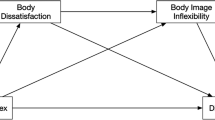Abstract
Objective: There are many health risks involved with the use of weight loss products by normal weight women. The mass media may compound this problem through the promotion of weight loss products and a thin body size. This study tested women’s perceptions of different weight loss product ads to determine if body dysphoria (i.e., an over concern with body size and shape in normal weight people) was associated with risk beliefs, past behaviors, and intention toward using weight loss products. Method: Normal weight women (age range = 18–41 yr), who were classified as either high (n=45) or low (n=43) on a measure of body dysphoria, rated different weight loss products according to their perception of health risks, past behavior, and their intention to consume the products. These products were a dietary fat substitute (olestra), a prescription obesity medication (sibutramine), and an over-the-counter appetite suppressant (phenylpropanolamine). Results: High body dysphoric women reported higher intentions to use the products as well as increased prior use of two of the three weight loss products. High body dysphoric women did not believe that these weight loss products were harmless. They recognized potential health risks associated with using such products, but nonetheless, expressed intention to use these weight loss products at a higher frequency. Also, several variables related to body image were found to effectively discriminate normal weight women at risk for abusing weight loss products. Discussion: This study found that women who do not need to lose weight but have significant body image concerns were willing to use potentially harmful weight loss products despite the knowledge that such products might pose significant health risks. Techniques utilized by advertising regulatory agencies such as warning labels did not have a strong deterrent effect for stated intentions to use the products. Implications of these findings for public health policy issues were discussed.
Similar content being viewed by others
References
Cleland R., Graybill D.C., Van Hubbard L.K.K., Stern J.S., Wadden T.A., Weinsier R., Yanovski S.: Commercial weight loss products and programs: What consumers stand to gain and lose a public conference on the information consumers need to evaluate weight loss products and programs. Clin. Rev. Food Sci. Nutr., 41, 45–70, 2001.
Berzins L.G.: Protecting the consumer through truth-in dieting laws. J. Soc. Issues, 2, 371–382, 1999.
Burton S., Netemeyer R.G., Lichtenstein D.: Gender differences for appearance-related attitudes and behaviors: Implications for consumer welfare. J. Public Policy & Marketing, 13, 60–75, 1995.
Whisenhunt B.L., Williamson D.A., Netemeyer R.G., Womble L.G.: Reliability and validity of the psychosocial risk factors questionnaire (PRFQ). Eat. Weight Disord., 5, 1–6, 2000.
Rabak-Wagner J., Eickhoff-Shemek J., Kelly-Vance L.: The effect of media analysis on attitudes and behaviors regarding body image among college students. J. Am. Health College, 47, 29–35, 1998.
Grigg M., Bowman J., Redman S.: Disordered eating and unhealthy weight reduction practices among adolescent females. Prev. Med., 25, 748–756, 1996.
Williamson D.A., Muller S.M., Reas D.L., Thaw J.A.: Cognitive bias in eating disorders: Implications for theory and treatment. Behav. Modif., 23, 556–577, 1999.
Williamson D.A.: Body image disturbances: A form of cognitive bias? Eating Disorders, 4, 47–58, 1996.
Andrews J.C., Netemeyer R.G., Burton S.: Consumer generalization of nutrient claims on advertising. J. Marketing, 62, 62–75, 1998.
Hoch S.J., Young-Won Ha: Consumer learning: Advertising and the ambiguity of product experience. J. Consumer Res., 13, 221–233, 1986.
Burke R.R., DeSarbo R.L.O., Robertson T.S.: Deception by implication: An experimental investigation. J. Consumer Res., 14, 483–494, 1988.
Luque C.A., Rey J.A.: Sibutramine: A serotoninnorepinephrine reuptake-inhibitor for the treatment of obesity. Ann. Pharmacother., 33, 968–978, 1999.
Bergholz C.M.: Safety evaluation of olestra, a nonabsorbed, fat-like fat replacement. Crit. Rev. Food Sci. Nutr., 32, 141–146, 1992.
Hampl J.S., Sheeley A.E., Schnepf M.I.: Sounding the alarm for misuse of olestra-containing foods in binge-eating disorders [Letter to the editor]. J. Am. Diet. Assoc., 98, 971, 1998.
Bulik C.M.: Abuse of drugs associated with eating disorders. J. Subst. Abuse, 4, 69–90, 1992.
Cooper P. J., Taylor M.J., Cooper Z., Fairburn C.G.: The development and validation of the Body Shape Questionnaire. Int. J. Eat. Disord., 6, 485–494, 1987.
Muller S.M., Williamson D.A., Martin C.K.: Reconstructing reality: The false consensus bias and its relationship to body dysphoria. Poster presented at the 32nd annual convention of the association for the advancement of behavior therapy, Washington, DC, 1998.
Williamson D.A., Barker S.E., Bertman L.J., Gleaves D.H.: Body image, body dysphoria, and dietary restraint: Factor structure in nonclinical subjects. Behav. Res. Ther., 33, 85–93, 1995.
Jackman L. J., Williamson D.A., Netemeyer R.G., Anderson D.A.: Do weight preoccupied women misinterpret ambiguous stimuli related to body size? Cognitive Ther. Res., 19, 341–355, 1995.
Kutlesic V., Williamson D.A., Gleaves D.A., Barbin J.M., Murphy-Eberenz K.P.: The Interview for the Diagnosis of Eating Disorders IV: Application to DSM-IV diagnostic criteria. Psychol. Assess., 10, 41–48, 1998.
Stunkard A.J., Messick S.: The Three-Factor Eating Questionnaire to measure dietary restraint, disinhibition, and hunger. J. Psychosom. Res., 29, 71–83, 1985.
Beck A.T., Steer R.A., Brown G.K.: Beck Depression Inventory-2nd] Edition. The Psychological Corporation: San Antonio, Harcourt Brace & Company, 1987.
Andrews J.C., Burton S., Netemeyer R.G.: Are some comparative nutrition claims misleading? The role of nutrition knowledge, ad-claim type, and disclosure conditions. J. Advertising, 29, 29–43, 2000.
Moorman C.: The effects of stimulus and consumer characteristics on the utilization of nutrition information. J. Consumer Res., 17, 362–374, 1990.
Petty R.E., Cacioppo J.T.: Communication and Persuasion: Central and Peripheral Routes to Attitude Change. New York, Sringer-Verlag, 1986.
Jacobson M., Corcoran L.: Snack attack: olestra. Nutrition Action Healthletter, (March), 9–11, 1998.
Author information
Authors and Affiliations
Corresponding author
Rights and permissions
About this article
Cite this article
Whisenhunt, B.L., Williamson, D.A., Netemeyer, R.G. et al. Health risks, past usage, and intention to use weight loss products in normal weight women with high and low body dysphoria. Eat Weight Disord 8, 114–123 (2003). https://doi.org/10.1007/BF03325000
Published:
Issue Date:
DOI: https://doi.org/10.1007/BF03325000




